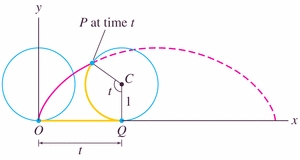- Assignment 8.2 returned.
- Assignment 9.2 due (remember, revised due dates....)
- Your test corrections are due next time: here's Exam 2 (if you want to make a copy for corrections)
- And now for something completely different....
A good introduction to parametric curves is given by ballistics. If we shoot a bullet into the air with speed v horizontally, and we neglect all forces but gravity, then the bullet will trace out a parabola:

Now how might we characterize the path of the bullet? The answer is a parametric curve, of the form C(t)=(x(t), y(t)).
or If we wish, we can solve for t in the equation for x and use that to eliminate the parameter t from the equation for y, hence getting an equation for the parabola traced out: Orbits of planets in the heavens, movements of ants on a hill, a robotic arm in an assembly plant: all these can be described by parametric curves.
- A couple of famous examples involving the cycloid:

- The Brachistochrone Problem (1696, solved by Newton in a single day after he heard the challenge)
- The Tautochrone Problem (1673)
- Parametrizing a line:

- Parametrizing a circle:

- There are two distinctively different kinds of derivatives that
we're going to have to consider here:
- There are the time-derivatives, which give us the actual
speeds of the "particles" as they zip along in time. For the bullet,
the speed will be
- There is the slope of the tangent line to the curve traced
out by the particle, which one can obtain using the time-derivatives:

- There are the time-derivatives, which give us the actual
speeds of the "particles" as they zip along in time. For the bullet,
the speed will be
- One very important applications of parametric curves is in the
Bezier curve section, p. 609. There are lots of important instances
where we need to be able to design custom curves, and this is one of
the most common ways of creating them. For example, you can use them to
create your own "sigmac",
using control
points. (I had all my students create their own in numerical
analysis.)
- Examples:
- #11, p. 611
- #14, p. 611
- #19, p. 611
- #22, p. 611
- #50, p. 612
- Today's lab features a critical application of parametric curves, however: Planetary Orbits (ellipses and more!). This is our last lab: you will turn in your lab notebooks (include only relevant pages, and you may tear those out and put them in a manilla folder, for example) with the final exam.
- I already indicated above what the speed should be -- so I'm not
going to spend much time on that.
How can we use this formula, however? Suppose a particle has followed the parametric curve
: then we can compute how far the particle has travelled during the interval
easily using the dirt formula,
(in its modified form
).
In this case, the rate is just the speed. So we compute the integral
This is actually just a re-expression of the arc length formula:
and
.
But arc length may be different from the distance the particle travelled: a particle can revisit many sections of the curve y(x) -- so once again we need to be careful to distinguish between the independent variable of interest (whether x or t).
- Other calculations can be generalized. For example, the formula
for surface area:

- Examples:
- #1, p. 620
- #13, p. 620; and let's start by developing the equations for the cycloid.
- #14, p. 620
- #21, p. 620
- #36, p. 621